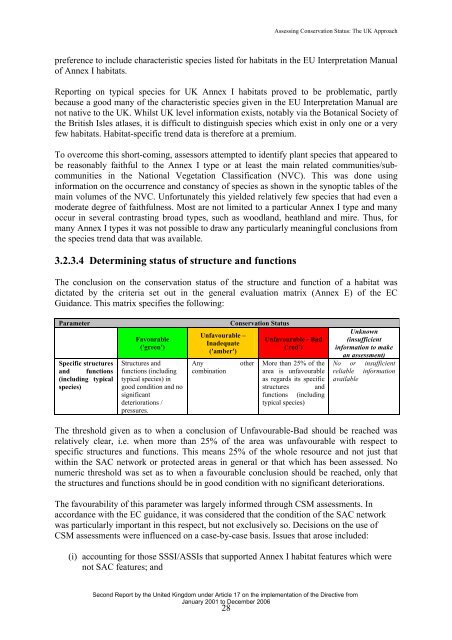Assessing Conservation Status: The UK Approach - JNCC
Assessing Conservation Status: The UK Approach - JNCC
Assessing Conservation Status: The UK Approach - JNCC
Create successful ePaper yourself
Turn your PDF publications into a flip-book with our unique Google optimized e-Paper software.
<strong>Assessing</strong> <strong>Conservation</strong> <strong>Status</strong>: <strong>The</strong> <strong>UK</strong> <strong>Approach</strong><br />
preference to include characteristic species listed for habitats in the EU Interpretation Manual<br />
of Annex I habitats.<br />
Reporting on typical species for <strong>UK</strong> Annex I habitats proved to be problematic, partly<br />
because a good many of the characteristic species given in the EU Interpretation Manual are<br />
not native to the <strong>UK</strong>. Whilst <strong>UK</strong> level information exists, notably via the Botanical Society of<br />
the British Isles atlases, it is difficult to distinguish species which exist in only one or a very<br />
few habitats. Habitat-specific trend data is therefore at a premium.<br />
To overcome this short-coming, assessors attempted to identify plant species that appeared to<br />
be reasonably faithful to the Annex I type or at least the main related communities/subcommunities<br />
in the National Vegetation Classification (NVC). This was done using<br />
information on the occurrence and constancy of species as shown in the synoptic tables of the<br />
main volumes of the NVC. Unfortunately this yielded relatively few species that had even a<br />
moderate degree of faithfulness. Most are not limited to a particular Annex I type and many<br />
occur in several contrasting broad types, such as woodland, heathland and mire. Thus, for<br />
many Annex I types it was not possible to draw any particularly meaningful conclusions from<br />
the species trend data that was available.<br />
3.2.3.4 Determining status of structure and functions<br />
<strong>The</strong> conclusion on the conservation status of the structure and function of a habitat was<br />
dictated by the criteria set out in the general evaluation matrix (Annex E) of the EC<br />
Guidance. This matrix specifies the following:<br />
Parameter<br />
Specific structures<br />
and functions<br />
(including typical<br />
species)<br />
Favourable<br />
('green')<br />
Structures and<br />
functions (including<br />
typical species) in<br />
good condition and no<br />
significant<br />
deteriorations /<br />
pressures.<br />
Unfavourable –<br />
Inadequate<br />
('amber')<br />
Any<br />
combination<br />
<strong>Conservation</strong> <strong>Status</strong><br />
other<br />
Unfavourable - Bad<br />
('red')<br />
More than 25% of the<br />
area is unfavourable<br />
as regards its specific<br />
structures and<br />
functions (including<br />
typical species)<br />
Unknown<br />
(insufficient<br />
information to make<br />
an assessment)<br />
No or insufficient<br />
reliable information<br />
available<br />
<strong>The</strong> threshold given as to when a conclusion of Unfavourable-Bad should be reached was<br />
relatively clear, i.e. when more than 25% of the area was unfavourable with respect to<br />
specific structures and functions. This means 25% of the whole resource and not just that<br />
within the SAC network or protected areas in general or that which has been assessed. No<br />
numeric threshold was set as to when a favourable conclusion should be reached, only that<br />
the structures and functions should be in good condition with no significant deteriorations.<br />
<strong>The</strong> favourability of this parameter was largely informed through CSM assessments. In<br />
accordance with the EC guidance, it was considered that the condition of the SAC network<br />
was particularly important in this respect, but not exclusively so. Decisions on the use of<br />
CSM assessments were influenced on a case-by-case basis. Issues that arose included:<br />
(i) accounting for those SSSI/ASSIs that supported Annex I habitat features which were<br />
not SAC features; and<br />
Second Report by the United Kingdom under Article 17 on the implementation of the Directive from<br />
January 2001 to December 2006<br />
28
















